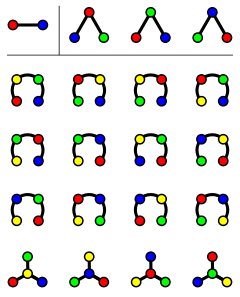Cayley's formula

In mathematics, Cayley's formula is a result in graph theory named after Arthur Cayley. It states that for every positive integer n, the number of trees on n labeled vertices is .
The formula equivalently counts the number of spanning trees of a complete graph with labeled vertices (sequence A000272 in the OEIS).
Proof
Many remarkable proofs of Cayley's tree formula are known.[1] One classical proof of the formula uses Kirchhoff's matrix tree theorem, a formula for the number of spanning trees in an arbitrary graph involving the determinant of a matrix. Prüfer sequences yield a bijective proof of Cayley's formula. Another bijective proof, by André Joyal, finds a one-to-one transformation between n-node trees with two distinguished nodes and maximal directed pseudoforests. A proof by double counting due to Jim Pitman counts in two different ways the number of different sequences of directed edges that can be added to an empty graph on n vertices to form from it a rooted tree; see Double counting (proof technique)#Counting trees.
History
The formula was first discovered by Carl Wilhelm Borchardt in 1860, and proved via a determinant.[2] In a short 1889 note, Cayley extended the formula in several directions, by taking into account the degrees of the vertices.[3] Although he referred to Borchardt's original paper, the name "Cayley's formula" became standard in the field.
Other properties
Cayley's formula immediately gives the number of labelled rooted forests on n vertices, namely (n+1)n-1. Each labelled rooted forest can be turned into a labelled tree with one extra vertex, by adding a vertex with label n+1 and connecting it to all roots of the trees in the forest.
There is a close connection with rooted forests and parking functions, since the number of parking functions on n cars is also (n+1)n-1. A bijection between rooted forests and parking functions was given by M. P. Schützenberger in 1968.
References
- ↑ Aigner, Martin; Ziegler, Günter M. (1998). Proofs from THE BOOK. Springer-Verlag. pp. 141–146.
- ↑ Borchardt, C. W. (1860). "Über eine Interpolationsformel für eine Art Symmetrischer Functionen und über Deren Anwendung". Math. Abh. der Akademie der Wissenschaften zu Berlin: 1–20.
- ↑ Cayley, A. (1889). "A theorem on trees". Quart. J. Math. 23: 376–378.